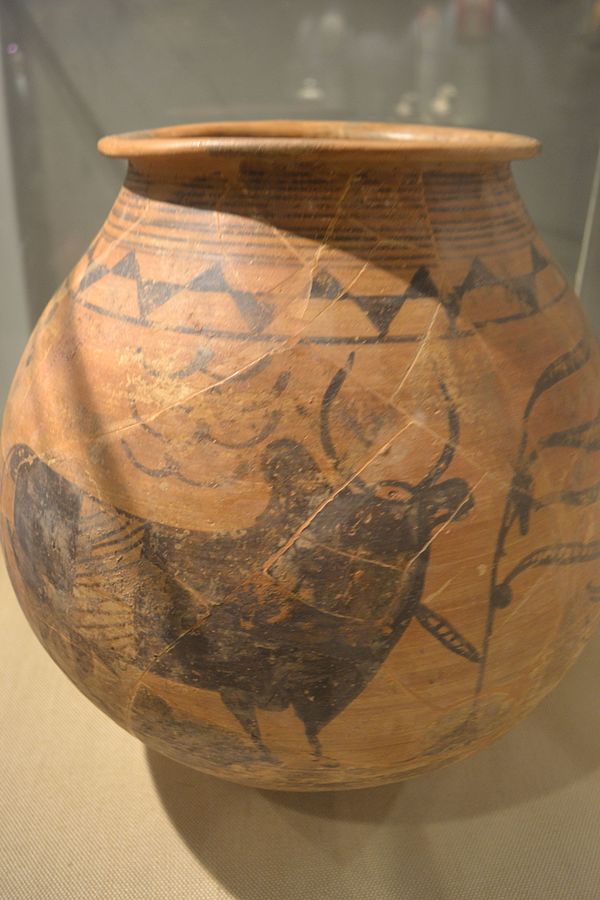Chromatography and compound specific isotope analysis of lipid remains in ancient pottery tell a lot about ancient ສະບຽງອາຫານ habits and culinary practices. In the last two decades, this technique has successfully been employed to unravel ancient ສະບຽງອາຫານ practices of several archaeological sites in the world. Researchers have applied this technique recently to the potteries collected from multiple archaeological sites of Indus Valley Civilisation. The key scientific finding was dominance of non-ruminant fats in the cooking vessels implying non-ruminant animals (such as horse, pigs, poultry, fowl, rabbit, etc) were cooked in the vessels over a long period. This contradicts the long held view (based on faunal evidence) that ruminant animals (such as cattle, buffalo, deer,etc) were consumed as ສະບຽງອາຫານ by Indus Valley people.
Archaeological excavations of important sites in the past century provided lot of information about the culture and practices of ancient people. However, understanding diet and subsistence practices prevalent in ancient prehistoric societies with no written records used to be an uphill task because not much of what constituted ‘food’ were left due to almost complete natural degradation of ສະບຽງອາຫານ and biomolecules. In the last two decades, the standard chemical techniques of chromatography and compound specific analysis of the ratio of stable isotopes of carbon have made inroads in archaeological studies enabling researchers to pinpoint sources of lipids. As a result, it has become possible to investigate diet and subsistence practices using molecular and isotopic analyses of absorbed food residues based on the δ13C and Δ13C values.
Plants are the primary producers of food. Most plants use C3 photosynthesis to fix carbon, hence are called C3 plants. Wheat, barley, rice, oats, rye, cowpea, cassava, soybean etc are the main C3 plants. They form the staple ສະບຽງອາຫານ of mankind. C4 plants (such as corn, sugarcane, millet, and sorghum) on the other hand, use C4 photosynthesis for carbon fixation.
Carbon has two stable isotopes, C-12 and C-13 (the third isotope C-14, is unstable hence radioactive and is used for dating ອິນຊີ archaeological finds). Of the two stable isotopes, the lighter C-12 is preferentially taken up in photosynthesis. Photosynthesis is not universal; it favours fixation of C-12. Further, C3 plants take up lighter C-12 isotope more than C4 plants do. Both C3 and C4 plants discriminate against heavier C-13 isotope but C4 plants do not discriminate as heavily as C3 plants. Put conversely, in photosynthesis, both C3 and C4 plants favour C-12 isotope over C-13 but C3 plants favours C-12 more than C4 plants. This results in differences in ratio of stable isotopes of carbon in C3 and C4 plants and in animals that feed on C3 and C4 plants. An animal fed on C3 plants will have more of lighter isotopes than an animal fed on C4 plants meaning a lipid molecule with lighter isotope ratio is more likely to have originated from an animal fed on C3 plants. This is the conceptual basis of compound specific isotope analysis of lipid (or any other biomolecule for that matter) that helps in identifying sources of lipid residues in the pottery. In a nutshell, C3 and C4 plants have different carbon isotopic ratios. The δ13C value for C3 plants is lighter between −30 and −23‰ while for C4 plants this value is between −14 and −12‰.
ຫຼັງຈາກການສະກັດເອົາ lipid ຕົກຄ້າງຈາກຕົວຢ່າງຂອງເຄື່ອງປັ້ນດິນເຜົາ, ຂັ້ນຕອນສໍາຄັນທໍາອິດແມ່ນການແຍກອົງປະກອບ lipid ທີ່ແຕກຕ່າງກັນໂດຍໃຊ້ເຕັກນິກຂອງ Gas chromatography-mass spectrometry (GC-MS). ນີ້ເຮັດໃຫ້ chromatogram lipid ຂອງຕົວຢ່າງ. lipids ຍ່ອຍສະຫຼາຍຕາມເວລາ, ດັ່ງນັ້ນສິ່ງທີ່ພວກເຮົາມັກຈະພົບເຫັນຢູ່ໃນຕົວຢ່າງວັດຖຸບູຮານແມ່ນອາຊິດໄຂມັນ (FA), ໂດຍສະເພາະແມ່ນອາຊິດ palmitic (C.16ແລະອາຊິດ stearic (C18). ດັ່ງນັ້ນ, ເຕັກນິກການວິເຄາະທາງເຄມີນີ້ຊ່ວຍໃນການກໍານົດອາຊິດໄຂມັນໃນຕົວຢ່າງແຕ່ວ່າມັນບໍ່ໃຫ້ຂໍ້ມູນກ່ຽວກັບຕົ້ນກໍາເນີດຂອງອາຊິດໄຂມັນ. ມັນຈໍາເປັນຕ້ອງໄດ້ຮັບການຢືນຢັນຕື່ມອີກວ່າອາຊິດໄຂມັນສະເພາະໃດຫນຶ່ງທີ່ລະບຸໄວ້ໃນເຮືອປຸງແຕ່ງອາຫານວັດຖຸບູຮານແມ່ນມາຈາກນົມຫຼືຊີ້ນສັດຫຼືພືດ. ອາຊິດໄຂມັນທີ່ຕົກຄ້າງຢູ່ໃນເຄື່ອງປັ້ນດິນເຜົາແມ່ນຂຶ້ນກັບສິ່ງທີ່ປຸງແຕ່ງຢູ່ໃນເຮືອໃນສະ ໄໝ ບູຮານ.
ພືດ C3 ແລະ C4 ມີອັດຕາສ່ວນທີ່ແຕກຕ່າງກັນຂອງ isotopes ຄົງທີ່ຂອງຄາບອນເນື່ອງຈາກການດູດເອົາສິດທິຂອງໄອໂຊໂທບ C12 ທີ່ອ່ອນກວ່າໃນລະຫວ່າງການສັງເຄາະແສງ. ເຊັ່ນດຽວກັນ, ສັດທີ່ລ້ຽງຢູ່ໃນພືດ C3 ແລະ C4 ມີອັດຕາສ່ວນທີ່ແຕກຕ່າງກັນ, ຕົວຢ່າງເຊັ່ນ, ສັດລ້ຽງລູກດ້ວຍນົມ (ສັດທີ່ລ້ຽງສັດເຊັ່ນງົວແລະຄວາຍ) ທີ່ກິນໃນອາຫານ C4 (ເຊັ່ນ: ເຂົ້າເມັດ) ຈະມີອັດຕາສ່ວນ isotope ທີ່ແຕກຕ່າງກັນກ່ວາສັດຂະຫນາດນ້ອຍເຊັ່ນ: ແບ້, ແກະ. ແລະໝູທີ່ມັກລ້ຽງສັດ ແລະຈະເລີນເຕີບໂຕໃນພືດ C3. ນອກຈາກນັ້ນ, ຜະລິດຕະພັນນົມແລະຊີ້ນທີ່ມາຈາກງົວ ruminant ມີອັດຕາສ່ວນ isotope ທີ່ແຕກຕ່າງກັນເນື່ອງຈາກຄວາມແຕກຕ່າງຂອງການສັງເຄາະໄຂມັນໃນຕ່ອມ mammary ແລະເນື້ອເຍື່ອ adipose. ການຢືນຢັນຕົ້ນກຳເນີດຂອງອາຊິດໄຂມັນສະເພາະທີ່ໄດ້ລະບຸໄວ້ກ່ອນໜ້ານັ້ນແມ່ນເຮັດໂດຍການວິເຄາະອັດຕາສ່ວນຂອງໄອໂຊໂທບທີ່ໝັ້ນຄົງຂອງຄາບອນ. ເຕັກນິກຂອງ Gas chromatography-combustion-isotopic ratio mass spectrometry (GC-C-IRMS) ຖືກນໍາໃຊ້ເພື່ອວິເຄາະອັດຕາສ່ວນ isotope ຂອງອາຊິດໄຂມັນທີ່ກໍານົດ.
ຄວາມສໍາຄັນຂອງການວິເຄາະອັດຕາສ່ວນຂອງ isotopes ຄາບອນທີ່ຫມັ້ນຄົງໃນ lipid residues ໃນການສຶກສາໂບຮານຄະດີຂອງສະຖານທີ່ prehistoric ໄດ້ສະແດງໃຫ້ເຫັນໃນປີ 1999 ໃນເວລາທີ່ການສຶກສາຂອງສະຖານທີ່ໂບຮານຄະດີໃນ Welsh Borderlands, UK, ສາມາດເຮັດໃຫ້ຈໍາແນກໄດ້ຢ່າງຊັດເຈນລະຫວ່າງໄຂມັນຈາກທີ່ບໍ່ແມ່ນ ruminant (ເຊັ່ນ: porcine) ແລະ. ຕົ້ນກຳເນີດຂອງໝາກໄຂ່ຫຼັງ (ເຊັ່ນ: ໝາກໄຂ່ຫຼັງ ຫຼື ລຳຕົ້ນ).1. ວິທີການນີ້ສາມາດສະຫນອງຫຼັກຖານສະຫຼຸບຂອງການລ້ຽງນົມຄັ້ງທໍາອິດໃນອາຟຣິກາ Saharan ສີຂຽວໃນສະຕະວັດທີຫ້າ BC. ອາຟຣິກາເຫນືອມີສີຂຽວທີ່ມີພືດພັນໃນຕອນນັ້ນແລະຊາວອາຟຣິກາ Saharan prehistoric ໄດ້ຮັບຮອງເອົາການປະຕິບັດການລ້ຽງນົມ. ນີ້ໄດ້ຖືກສະຫຼຸບບົນພື້ນຖານຂອງ δ13C ແລະ Δ13C ຄ່າຂອງອາຊິດ alkanoic ທີ່ສໍາຄັນຂອງໄຂມັນ້ໍານົມທີ່ລະບຸໄວ້ໃນເຄື່ອງປັ້ນດິນເຜົາ.2. ການວິເຄາະທີ່ຄ້າຍຄືກັນໄດ້ໃຫ້ຫຼັກຖານໂດຍກົງທີ່ໄວທີ່ສຸດຂອງການປຸງແຕ່ງນົມແລະການບໍລິໂພກໂດຍສັງຄົມ neolithic pastoral ໃນອາຟຣິກາຕາເວັນອອກ3 ແລະໃນຕົ້ນສະບັບເຫຼັກ, ພາກເຫນືອຂອງຈີນ4.
ໃນເອເຊຍໃຕ້, ຫຼັກຖານຂອງການເຂົ້າປະເທດມີມາຕັ້ງແຕ່ປີ 7th ສະຫັດສະຫວັດ BC. ໂດຍ 4th millennium BC, domesticated animals like cattle, buffalo, goat, sheep etc were present across various Indus Valley sites. There were suggestions of utilisation of these animals in food for dairy and meat but no conclusive scientific evidence to support the view. Stable isotope analysis of lipid residue extracted from ceramic shreds collected from ຮ່ອມພູ Indus settlements provide the earliest direct evidence of dairy processing in South Asia5. ໃນອີກປະການຫນຶ່ງທີ່ຜ່ານມາ, ການສຶກສາລະອຽດກວ່າ, ເປັນລະບົບຂອງ lipid residue ຈາກຊິ້ນຫມໍ້ທີ່ເກັບກໍາຈາກຫຼາຍສະຖານທີ່ Indus Valley, ນັກຄົ້ນຄວ້າໄດ້ພະຍາຍາມສ້າງປະເພດຂອງອາຫານທີ່ໃຊ້ໃນເຮືອ. ການວິເຄາະໄອໂຊໂທບຢືນຢັນການນໍາໃຊ້ໄຂມັນສັດໃນເຮືອ. ການຄົ້ນພົບທາງວິທະຍາສາດຫຼັກແມ່ນການຄອບງຳຂອງໄຂມັນທີ່ບໍ່ມີທາດ ruminant ໃນເຮືອປຸງແຕ່ງອາຫານ6 ບົ່ງບອກເຖິງສັດທີ່ບໍ່ມີສັດປ່າ (ເຊັ່ນ: ມ້າ, ໝູ, ສັດປີກ, ໄກ່, ກະຕ່າຍ, ແລະອື່ນໆ) ຖືກນຳມາປຸງແຕ່ງໃນເຮືອເປັນເວລາດົນນານ ແລະ ບໍລິໂພກເປັນອາຫານ. ນີ້ຂັດກັບທັດສະນະທີ່ຖືເປັນເວລາດົນນານ (ອີງໃສ່ຫຼັກຖານຂອງສັດ) ທີ່ສັດທີ່ຢູ່ອາໃສ (ເຊັ່ນ: ງົວ, ຄວາຍ, ກວາງ, ແບ້ແລະອື່ນໆ) ຖືກບໍລິໂພກເປັນອາຫານໂດຍປະຊາຊົນ Indus Valley.
ການຂາດການມີໄຂມັນອ້າງອີງທີ່ທັນສະໄຫມໃນທ້ອງຖິ່ນ ແລະຄວາມເປັນໄປໄດ້ຂອງການປະສົມພືດ ແລະຜະລິດຕະພັນສັດແມ່ນຂໍ້ຈຳກັດຂອງການສຶກສານີ້. ເພື່ອເອົາຊະນະຜົນກະທົບທີ່ເປັນໄປໄດ້ທີ່ເກີດຈາກການປະສົມຂອງຜະລິດຕະພັນພືດແລະສັດ, ແລະສໍາລັບທັດສະນະລວມ, ການວິເຄາະເມັດແປ້ງໄດ້ຖືກລວມເຂົ້າໃນການວິເຄາະ lipid residue. ນີ້ສະຫນັບສະຫນູນການປຸງແຕ່ງອາຫານຂອງພືດ, ຫານປະເພດເມັດ, ກໍາມະຈອນເຕັ້ນແລະອື່ນໆໃນເຮືອ. ນີ້ຊ່ວຍເອົາຊະນະບາງຂໍ້ຈໍາກັດ7.
***
ເອກະສານ:
- Dudd SN et al 1999. ຫຼັກຖານສໍາລັບຮູບແບບທີ່ແຕກຕ່າງກັນຂອງການຂູດຮີດຜະລິດຕະພັນສັດໃນປະເພນີເຄື່ອງປັ້ນດິນເຜົາໃນສະໄຫມກ່ອນປະຫວັດສາດທີ່ແຕກຕ່າງກັນໂດຍອີງໃສ່ lipids ເກັບຮັກສາໄວ້ໃນພື້ນຜິວແລະການດູດຊຶມສານຕົກຄ້າງ. ວາລະສານວິທະຍາສາດໂບຮານຄະດີ. ເຫຼັ້ມທີ 26, ສະບັບທີ 12, ເດືອນທັນວາ 1999, ໜ້າ 1473-1482. DOI: https://doi.org/10.1006/jasc.1998.0434
- Dunne, J., Evershed, R., Salque, M. et al. ການລ້ຽງນົມຄັ້ງທໍາອິດໃນອາຟຣິກາ Saharan ສີຂຽວໃນສະຕະວັດທີຫ້າ BC. ທໍາມະຊາດ 486, 390–394 (2012). DOI: https://doi.org/10.1038/nature11186
- Grillo KM ແລະ al 2020. ຫຼັກຖານໂມເລກຸນ ແລະໄອໂຊໂທບສຳລັບນົມ, ຊີ້ນ, ແລະພືດໃນລະບົບອາຫານລ້ຽງສັດໃນອາຟຣິກາຕາເວັນອອກກ່ອນປະຫວັດສາດ. PNAS. 117 (18) 9793-9799. ຈັດພີມມາໃນວັນທີ 13 ເມສາ 2020. DOI: https://doi.org/10.1073/pnas.1920309117
- Han B., et al 2021. ການວິເຄາະການຕົກຄ້າງຂອງ lipid ຂອງເຮືອເຊລາມິກຈາກສະຖານທີ່ Liujiawa ຂອງ RuiState (ຍຸກທາດເຫຼັກຕົ້ນ, ພາກເຫນືອຂອງຈີນ). Journal Of Quaternary Science (2022)37(1) 114–122. DOI: https://doi.org/10.1002/jqs.3377
- Chakraborty, KS, Slater, GF, Miller, H.ML. et al. ການວິເຄາະໄອໂຊໂທບສະເພາະຂອງ lipid residues ສະຫນອງຫຼັກຖານໂດຍກົງທໍາອິດທີ່ສຸດຂອງການປຸງແຕ່ງຜະລິດຕະພັນນົມໃນອາຊີໃຕ້. Sci Rep 10, 16095 (2020). https://doi.org/10.1038/s41598-020-72963-y
- Suryanarayan A., et al 2021. Lipid ຕົກຄ້າງໃນເຄື່ອງປັ້ນດິນເຜົາຈາກອາລະຍະທຳ Indus ໃນພາກຕາເວັນຕົກສຽງເໜືອຂອງອິນເດຍ. ວາລະສານວິທະຍາສາດໂບຮານຄະດີ. ເຫຼັ້ມທີ 125, 2021,105291. DOI:https://doi.org/10.1016/j.jas.2020.105291
- García-Granero Juan José, et al 2022. ການປະສົມປະສານການວິເຄາະເມັດໄຂມັນ ແລະທາດແປ້ງຈາກເຮືອເຄື່ອງປັ້ນດິນເຜົາ ເພື່ອສຳຫຼວດເສັ້ນທາງອາຫານກ່ອນປະຫວັດສາດໃນລັດກູຈາຣາດ, ປະເທດອິນເດຍ. ເຂດແດນໃນລະບົບນິເວດ ແລະວິວັດທະນາການ, ວັນທີ 16 ມີນາ 2022. Sec. ບູຮານຄະດີ. DOI: https://doi.org/10.3389/fevo.2022.840199
ບັນນານຸກົມ
- Irto A., et al 2022. Lipids ໃນເຄື່ອງປັ້ນດິນເຜົາໂບຮານຄະດີ: ການທົບທວນຄືນກ່ຽວກັບເຕັກນິກການເກັບຕົວຢ່າງແລະການສະກັດເອົາຂອງເຂົາເຈົ້າ. ໂມເລກຸນ 2022, 27(11), 3451; DOI: https://doi.org/10.3390/molecules27113451
- Suryanarayan, A. 2020. ການປຸງອາຫານໃນອາລະຍະທຳອິນດູແມ່ນຫຍັງ? ການສືບສວນອາຫານ Indus ຜ່ານການວິເຄາະສານຕົກຄ້າງ lipid ເຊລາມິກ (ທິດສະດີປະລິນຍາເອກ). ມະຫາວິທະຍາໄລ Cambridge. DOI: https://doi.org/10.17863/CAM.50249
- Suryanarayan, A. 2021. ການບັນຍາຍ – Lipid residues in pottery from the Indus Civilization. ມີຢູ່ https://www.youtube.com/watch?v=otgXY5_1zVo
***






































